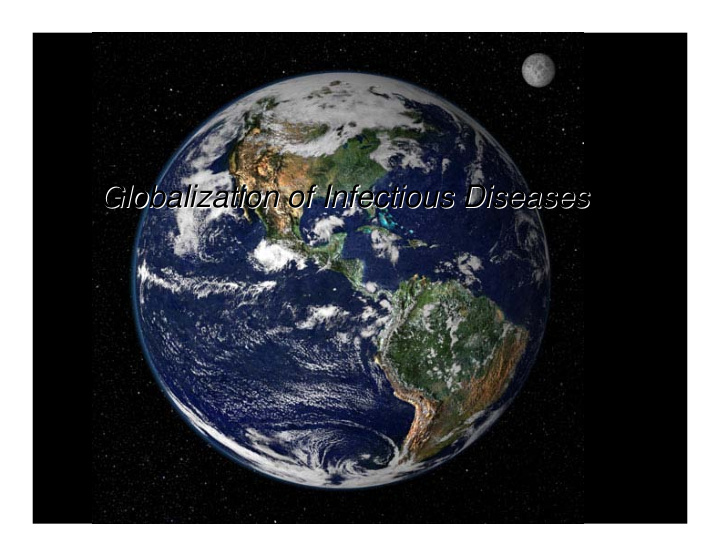



Globalization of Infectious Diseases Globalization of Infectious Diseases
Origin of Some Infectious Disease Agents Ebola West Nile Lassa Norwalk Coxsackie Lyme Hanta
Ecological Factors Influencing the Emergence of Infectious Diseases Geography Geography Climate Climate Weather Weather Animal Migration Animal Migration Human Encroachment and Forced Migration Human Encroachment and Forced Migration Natural Disasters (floods, fire, hurricanes, etc.) Natural Disasters (floods, fire, hurricanes, etc.) Vector Biology Vector Biology
To learn more, log on to: www.medicalecology.org
Host-Agent Interactions Host-Agent Interactions Contact with host - route of entry Dose - how many organisms does it take to infect? Frequency - how often must the host be exposed? Adherence - what are the host receptor molecules Adaptability of agent- e.g., antigenic variation, interference with host immune system
Cholera
C holera Pandemic s
Cholera Cholera Then and Now and Now Then John Sno w R ita Colwe lm
Distribution Of Estuaries
Trophic Relationships Of The Mangrove Estuary From: E. Odum Fundamentals Of Ecology
Ecology of Cholera Ecology of Cholera Numbers increase during monsoons due to phytoplankton blooms Filter-feeding Epidemics Epidemics Copepod crustacea Cholera bacteria Cholera bacteria Throw net fishing for crustacea after the monsoons in Bay of Bengal Fecal contamination of freshwater and human activities
Monsoons 1. lower the salinity of the estuary 2. bring nutrients to the estuary 3. raise the ambient water temperature of the estuary
Influenza Influenza
Common and Not So Common Strains of the Influenza Virus H5N1 - 2004 “Avian” influenza All ages susceptible
In 1918-1919, Influenza killed some killed some In 1918-1919, Influenza 40-100 million people, worldwide worldwide 40-100 million people,
Influenza Virus: Structure and Function
S pread o f A vian In fl uenza Viru s C our tf sy BBC
Asian Waterfowl Flyways Asian Waterfowl Flyways
H uman Case s C our tf sy BBC
Hanoi Chicken Farmer Going to Market Courtesy Andrew Rosenblatt
+ + ? + + ???? W hat wi lm happen next?
World Air Routes
Rabies Rabies
World Distribution of Rabies
Rabies vectors and carriers
B e lma B e lma L ugos i L ugos i : : P a ts on Saint o f P a ts on Saint o f a lm bat specie s a lm bat specie s Vampire Bat rabies virus Did you know? 30% of all mammalian species are bats
ProMed: Oct 27th, 2005 From: Luciano Goldani <rsf4805@via-rs.net> Hematophagous (vampire) bats are proliferating because of forest devastation in the state of Maranhao, northeastern Brazil. 20 cases of fatal rabies have been clinically documented. The population in the area is protecting their houses with wire nets to prevent bat bites. Dr. Luciano Goldani Infectious Diseases Unit Universidade Federal do Rio Grande do Sul Brazil
L ive virus vaccine i n oral bait s
Control of rabies by oral bait-vaccine
Yellow Fever Yellow Fever Walter Reed Distribution of Yellow Fever “A man, a plan, a canal. Panama”
P anama Canal: Ti e Early day s
Canopy Transmission Canopy Transmission By Haemogogus Haemogogus sp. sp. By
Ecology of Transmission Of Yellow Fever Ecotone
Occupations at High Risk Sugar cane Coffee Revolutionary Rubber
African Trypanosomiasis
East African Savanna
West African River
Riverine Tsetse and agriculture
Civil Unrest and War - 2005 Liberia Côte-d’Ivoire Sudan Cases - 400,000/yr - 400,000/yr Cases Ethiopia Deaths - 60,000/yr - 60,000/yr Deaths Nigeria Sierra Leone Guinea Ghana Burundi Burkina Faso Refugees Cameroon Gambia Rwanda Swaziland Mauritania Zambia Central African Republic Namibia Democratic Republic of Congo
What’ ’s Next?? s Next?? What
Without a global ecological perspective on infectious disease transmission, we will forever remain sitting ducks! Us Infectious diseases
Recommend
More recommend